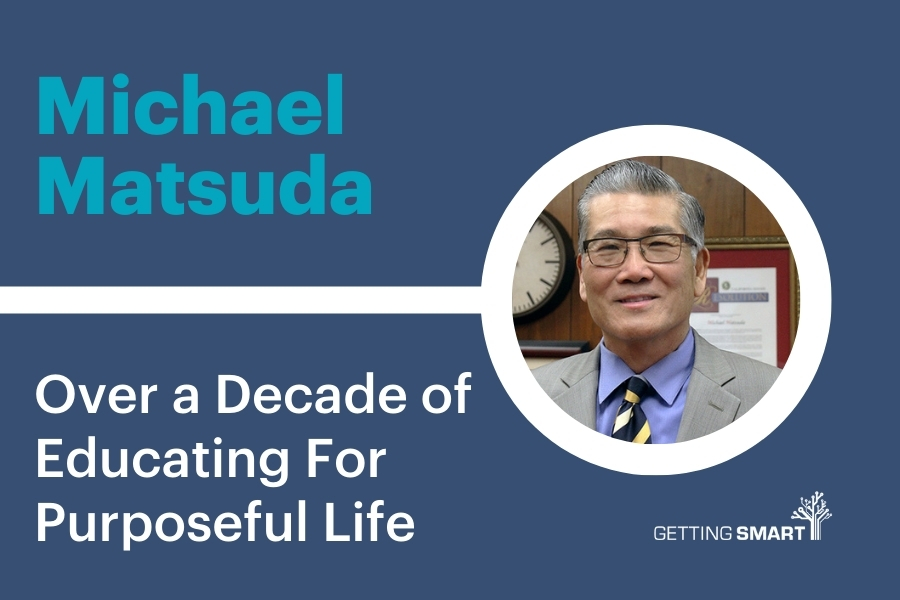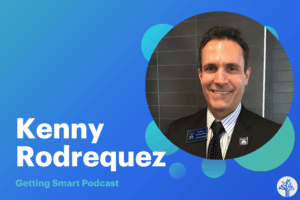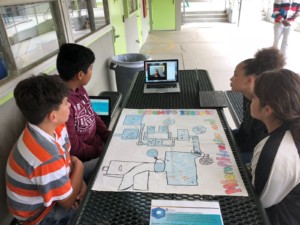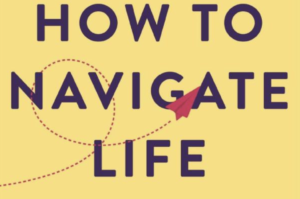Michael Matsuda on Over a Decade of Educating For Purposeful Life
Key Points
-
Students are volunteers in the system – they need more opportunities for agency and voice.
-
It’s critical that curriculum specialists are also bought in on your district’s mission and vision.
-
Colleges are crediting Anaheim students excelling performance for their ability to find purpose and agency.

This episode of the Getting Smart Podcast is a part of our New Pathways campaign. In partnership with American Student Assistance (ASA), the Bill & Melinda Gates Foundation, Stand Together and the Walton Family Foundation, the New Pathways campaign will question education’s status quo and propose new methods of giving students a chance to experience success in what’s next.
On this episode of the Getting Smart Podcast we’re joined by Superintendent Michael Matsuda. Superintendent Matsuda has served in his role at Anaheim Union High School District for a decade and is also the author of the great new book: Educating for Purposeful Life: A New Conception of Schooling for the 21st Century.
The mission of the Anaheim Union High School District is to prepare high school graduates who possess a clear sense of purpose and the capacity to achieve their goals … talk about a pathways vision. The Career Preparedness Systems Framework is a great framework for helping to map AUHSD’s vision onto real students day in and day out.

Dr.
Links:
- Michael Matsuda Bio
- Educating for Purposeful Life: A New Conception of Schooling for the 21st Century
- Career Preparedness Systems Framework
- Anaheim Union High School District
- Ben Wildavsky on The Career Arts: Answering Big Questions About College and Career
- American Student Assistance
- New Pathways
Transcript
Tom Vander Ark: The mission of the Anaheim Union High School District is to prepare high school graduates who possess a clear sense of purpose and the capacity to achieve their goals. I love that mission. I love the combination of purpose and capacity. Think of a vector of helping every kid develop their own sense of direction and energy on that mission. That’s really at the heart of our new pathways campaign. I’m Tom Vander Ark and you’re listening to the Getting Smart podcast. Today, I have the pleasure of being joined by Michael “Mike” Matsuda, the superintendent in Anaheim. He’s also the author of a terrific new book called “Educating for a Purposeful Life: A New Conception of Schooling for the 21st Century.” Mike, what a treat to have you on the podcast. You have a fantastic leadership story. You’ve been superintendent there almost…
Michael Matsuda: It’s great to be here, Tom Vander Ark… going on, It’ll be 10 years in March.
Tom Vander Ark: 10 years, is that right? You know, Mike, I think I realized after 5 years as a superintendent that it was going to take me 10 years to do my 3-year plan. Really, it takes 10 years to do important work, doesn’t it?
Michael Matsuda: Yeah, it does. I’ve been very fortunate to have a great team.
Tom Vander Ark: But you’ve been in the district for a while. You taught there, you were a school administrator. So, I’d love the sort of origin story of when you shifted to becoming superintendent. How did you frame and initiate this amazing change process that you’ve been on?
Michael Matsuda: Well, the inflection point was about 2012. We had seven police shootings, most involving fatalities of Latino youth in our city of Anaheim. It was the most in the United States, so there were riots in the streets. And of course, we’re in the shadow of Disneyland, so that cannot happen in the city of Anaheim. The then-mayor, Tom Vander Ark Tate, and I worked in the district as leader of professional development, and we had a number of restorative circles with students who were basically saying, “Look, we feel we have no future here in Anaheim other than the gang life.” So, they really put pressure on us to change the trajectory of schools and the relationship with the city, and to provide access to a meaningful and purposeful job. So that’s really the origin story leading to what we have now.
Tom Vander Ark: But Mike, your new book, “Educating for a Purposeful Life,” really goes into some detail on the career preparedness framework that you developed. How did that develop over what period of time, and what kind of influences helped you develop that frame?
Michael Matsuda: Yeah, so I want to give a shout-out to my co-author, David Brazer of Stanford. That started ten or eleven years ago when I became superintendent in 2014. We really felt we needed to make this shift into career preparedness, away from test scores. We pulled away from teaching to the test or any sort of fact in our district. We don’t even mention test scores. The then-mayor, Tom Vander Ark Tate, brought in some corporate leaders and we had a meeting with about a dozen of them. We were not asking for any money or support other than mentorship and time. We got about eight to ten of them to agree, and that’s how our career pathways really began to now, where we have over one hundred corporate and nonprofit partners, and probably one of the most robust CTE pathways based on a student’s purpose and passion. So, we’re really proud of the work that we’ve done since then.
Tom Vander Ark: That framework surfaces 21st-century skills plus technical skills, and then you add youth voice. Why do you think that’s the third leg on the stool?
Michael Matsuda: The youth voice is vital because, as my colleague David Brazer says, especially during the pandemic, I think districts realize that students are volunteers. They can choose not to come, and often, they realized during the pandemic that they can get a lot of information on the internet. They don’t necessarily need schools to have an education. So, we felt students are volunteers. They need more agency in the system, more voice, and more sense of belonging. We really work on teasing out youth voice, which leads to a purpose, leads to a major, and leads to what they might want to do as a job. I think one of your former guests, Ben Vodowski, spoke very eloquently about the need for 7-12 systems to work on purpose, and that is going to help them throughout college and throughout life.
Tom Vander Ark: One of the sponsors of our New Pathways campaign, Mike, is American Student Assistance (ASA). They are really the leading advocate for middle grade career exploration, as well as youth voice and agency. Your book goes into detail on how you think about this as a 7-12 system. What’s middle school like in Anaheim, and how do you start career exploration in the middle grades?
Michael Matsuda: Well, it really is nested in what we call performance task assessments leading to capstone portfolios, digital portfolios. That’s in every grade. We have capstone interviews and exit interviews in eighth grade and again in twelfth grade, but this is not just a one-and-done thing. It begins on the first day of school through the performance task assessments, which have integrated each of these three drivers of CPSF. We call it 21st-century skills, like the five C’s: critical thinking, creativity, collaboration, communication, and compassion, as well as the actual pathways. The third one is student voice, which really begins in seventh and eighth grade. If you think about the construct of a TED Talk, for example, that’s a great way to affirm a student’s own narrative, their own stories, and help them figure out their passion in life. So, there’s a lot of exploratory types of careers and looking at student assets in seventh, eighth, and ninth grade, leading more into career pathways.
Tom Vander Ark: I want to go all the way back to the beginning and have you talk more about changing the narrative. This is your opening chapter. High school has such a thick narrative, right? There’s a lot of tradition around how we do things. How did you change the narrative both in the school and in the community and get refocused on this mission?
Michael Matsuda: Right now, a lot of districts are struggling with chronic absenteeism and learning loss. I think it’s more about engagement loss. In terms of changing the narrative, there are many examples of that where kids find their own narrative. We started a cybersecurity pathway in 2017, and we had kids whose parents worked as day laborers at Home Depot. They’re from Mexico and were on that pathway. Changing the narrative is basically getting that same kid to think about cybersecurity or biotech, taking dual credit courses, and actually graduating with two dual credit courses from community college in cybersecurity or biotech or AI, and getting jobs upon high school. We have kids getting jobs at $60,000 to $70,000 a year with a high school diploma, whose narrative would have been working at Home Depot. Now, they’re making a lot of money, pushing six-figure incomes with a high school diploma. That’s changing the narrative in less than one generation.
Tom Vander Ark: The second chapter is about systems thinking. You start to get into the nuts and bolts of the change process and how you think about systems architecture. How would you describe the change effort? Was it a whole district altogether, or did you phase it in by theme or by school readiness? How did you organize the change effort?
Michael Matsuda: The CPSF, the three drivers that we talked about, came around 2020, right about during the pandemic. We were concerned about things becoming siloed. We were focused on student voice, on whole child education, working with community colleges and our ROP programs for those CTE pathways, and that became sort of a convergence. One of the points we make in terms of systems is that it’s easy to talk about systems, but very difficult to actually wrestle with that. Oftentimes, there’s this tension in terms of what you perceive as reality versus what is real. You have to have people around you within that learning organization that are able to see the blind spots of your organization and say, “Look, we got to do something about this.” Sometimes it’s navigating the associations, sometimes it’s navigating the faculty senate at community colleges, sometimes it’s working with parents so that they understand the change. It took a lot for us to move away from test scores. There was a lot at risk because we knew if our test scores went down, we were all going to go down, including myself. So, we really focused on reflective reading and literary writing, unleashing the innovative power of teachers, which is important to underscore. There are amazing teacher leaders at every one of our sites, and if we unleash that innovation and creativity, we’re going to unleash all the creativity and potential of kids.
Tom Vander Ark: Are your high schools organized around career pathways?
Michael Matsuda: Yes, they are. California has identified about 20 different career pathways, and we have 17 of them across an array of both traditional and more forward-thinking pathways. We also have specific, exclusive pathways at each one of our high schools. I mentioned cybersecurity, biotech, artificial intelligence, and drone pathways. Schools get stuck in developing these pathways when they think very traditionally in terms of who they have in front of them at the high school level. But I say, once you start enlarging your aperture of what school is, schools are at home. They are a community center and beyond. So, we have this great program called “Saturdays in Anaheim” where you can do anything from take drone courses to cybersecurity classes to make tamales and read to your kid. That, to me, is what schools ought to be in the 21st century. We have about 1,000 to 2,000 people in our high schools on Saturdays, bringing in college professors to teach alongside teachers.
Tom Vander Ark: How do you assess youth voice?
Michael Matsuda: So, there are a number of ways. We do a lot of surveys. I do a lot of anecdotal feedback. We have feedback circles from a lot of our students, some very informal. One of my favorite stories is when we have informal lunches. We bring pizzas in and talk to students. I remember talking to a group of students in one of our alternative high schools, and one of the students said, “Mr. Matsuda, don’t ever invite us to lunch again because we feel like it’s just kind of a dog and pony show.” We took that feedback to heart. So now, we work with groups like YouthTruth to gather more formal feedback to get a sense of how students are feeling in terms of agency. At our state level, we have a dashboard that has academic, attendance, and school culture data. We use all that data to assess where we are in terms of student voice. At the end of the day, if you’re focusing on the whole child, you have to listen to them and take their feedback seriously. We work with our mental health providers to give us assessments. It’s a lot of mixed methods.
Tom Vander Ark: What’s the best part about the change process in Anaheim?
Michael Matsuda: The best part about the change process in Anaheim is the relationships that are built. As I said, if you can unleash the innovative spirit of teachers, you can see amazing things happen. But it does take time. We’re talking years, not weeks or months. We have to be patient with ourselves. Change doesn’t happen overnight, but it’s worth it when you see the fruits of your labor in the success and happiness of your students and staff.
Tom Vander Ark: Thanks for sharing your incredible journey and insights with us, Mike. I’m sure your story will inspire many other educators and leaders in their own paths of transformation.Michael Matsuda: Thank you, Tom Vander Ark. It’s been a pleasure to be here and share our work.









0 Comments
Leave a Comment
Your email address will not be published. All fields are required.